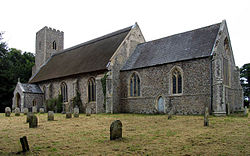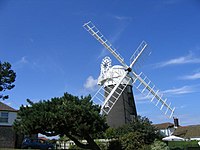Difference between revisions of "Paston, Norfolk"
(Created page with "{{Infobox town |name=Paston |county=Norfolk |picture=Saint Margaret Paston.jpg |picture caption=St Margaret, Paston |os grid ref=TG275387 |latitude=52.85781 |longitude=1.4498...") |
(No difference)
|
Latest revision as of 19:15, 13 April 2021
| Paston | |
| Norfolk | |
|---|---|
 St Margaret, Paston | |
| Location | |
| Grid reference: | TG275387 |
| Location: | 52°51’28"N, 1°26’59"E |
| Data | |
| Population: | 239 (2011, parish) |
| Post town: | North Walsham |
| Postcode: | NR28 |
| Local Government | |
| Council: | North Norfolk |
| Parliamentary constituency: |
North Norfolk |
Paston is a village in Norfolk, four mile north-east of North Walsham, nine miles south-east of Cromer, and nineteen miles north-east of the county town, the City of Norwich.
The village sits astride the coast road between Mundesley and Bacton.
The village gives its name to the Pastonian Stage, a British regional subdivision of the Pleistocene Epoch. The village was served by Paston & Knapton railway station on the North Walsham to Cromer section of the Norfolk and Suffolk Joint Railway from 1881 until 1964.
Contents
History
The manor of Paston is listed in the Domesday Book of 1086[1] as Pastuna, and was one of the many English holdings of William de Warenne, 1st Earl of Surrey. The listing mentions the church and a mill.
From about 1400 the village was dominated by the de Paston family (later Paston), who had taken their surname from their seat. Clement Paston was sufficiently wealthy to have his son William Paston (1378–1444) educated as a lawyer and he later become a judge. The family went on to acquire lands throughout the county, and there is an old saying in Norfolk that "There was never a Paston poor, a Heydon a coward or a Cornwallis a fool".[2] The Paston family are remembered today mostly for the Paston Letters, a rare surviving collection of fifteenth century private and business letters; correspondence of members of the family, and others connected with them, between 1422 and 1509, and including some state papers and other important documents. Most of the Paston letters and associated documents are now in the British Library, but a few are in the Bodleian Library, Oxford, at Magdalen College, Oxford, and at Pembroke College, Cambridge.s.[3]
Mediæval life in Paston was dangerous because of raids from the sea by French ships. A letter of Agnes Paston (dated 11 March 1450, written at Norwich) reports that Richard Lynsted had been to see her from Paston that day and had let her know that Warren Harman's half-brother had been 'taken with enemies' while walking along the sea side. Two pilgrims, a man and a woman, had also been attacked. Agnes also mentions that the pirates 'have thys weke takyn iiij (4) vessellys of Wyntyrton and Happysborough, and Ecles men been sore aferd for takyn of mo, for there ben x (10) grete vessellys of the enemyis'.[4]
In 1597 Sir William Paston (1528–1610) moved the main family seat to Oxnead.
The last Paston in the male line was William Paston, 2nd Earl of Yarmouth (d.1732).[5] The Paston estate was then acquired by Baron Anson, passing in the early nineteenth century to the Mack family.[6]
Archaeological test pits were dug in 2012.[7] The report was published online. [8]
Parish church
The parish church of St Margaret dates from the 14th century and is constructed from flint.[9] It is a Grade I listed building.[10]
The church has an embattled tower which looks down on a thatched roof. The porch is on the south side and opens into a plain nave and chancel which is divided by a 15th century rood screen.[11] The church has been restored three times, in 1601, 1843 and 1869.[12] In 1922 mediæval wall paintings were uncovered, one depicting St Christopher carrying the Christ child, another depicting the legend of the three kings who, when hunting merrily in the forest, suddenly encountered three hanging skeletons.[13] There is also a small figure from a 'weighing of souls' and the remains of some post-Reformation texts.[14]
At the eastern end of the church are numerous monuments to the Paston family, lords of the manor. That of Katherine Knevet/Knyvett (d.1628), the wife of Sir Edmund Paston, stands on the north side of the chancel, was carved by Nicholas Stone, master-mason to King Charles I, and includes a verse epitaph written by the poet John Donne himself.[15] The monument is made of alabaster and pink-veined marble and features a semi-recumbent effigy of Lady Paston sculpted in white marble and surrounded by numerous allegorical figures. Stone also designed the adjoining monument to her husband Sir Edmund Paston (d.1632), comprising a plain urn on a bare base in an aedicule of black Doric columns. Pevsner commented: "the contrast between the severity of the one and the ebullience of the other is startling".[16] The chancel also contains three chest tombs, the one at the eastern end probably of John Paston (d.1466) who was originally buried in Bromholm Priory following a magnificent funeral at which were consumed forty barrels of ale.
Surviving monuments to the Mack family include stained glass windows and memorial plaques are found in the nave. The south window next to the doorway of the rood loft is dedicated to Lt Cdr Ralph Michael Mack of the Royal Navy who went down with his ship HMS Tornado off the Dutch coast in 1917.
Paston Hall
The original Paston Hall was built by William Paston (1378–1444) and was partly destroyed by fire during the reign of King Henry VIII. It was replaced by a 'great rose-coloured mansion' that appears in a portrait of Sir William Paston (1528–1610). According to Blomefield's History of Norfolk (1739/75) the new building had two court-yards, the inner one containing a well. Blomefield reported that the great hall was still standing but the chambers and chapel were in ruins. The canting arms of the Barre/Barrey/Berry family (Argent, a chevron between three bear's heads couped at the neck sable muzzled and collared or) could still be seen carved over a doorway, symbolising the 1420[17] marriage of William Paston of Paston, Judge, son and heir of Clement Paston and Beatrix Somerton, to Agnes Barrey, a daughter and co-heiress of Sir Edmund Barrey.[18]
In the eighteenth century Baron Anson acquired the estate from the impecunious William Paston, 2nd Earl of Yarmouth, and rebuilt the manor house on the same site. The remnants of the old house were left standing. An account written in 1796 states that the ruins stood at the east side of the courtyard with new domestic rooms on the north and south sides and a turreted gateway on the west. The gateway was described as being built of flint with quoins of freestone, with extensive cellars. An engraving of 1823 shows several polygonal chambers; excavations carried out in 1900 revealed the foundations of a hexagonal chamber. In 1824 John Mack acquired the estate and built the surviving house which incorporates parts of the Anson house and the Tudor cellars.[6]
At various times Paston Hall has been surrounded by outhouses, shrubberies, orchards and lawns. To the south east is a small field known as the 'Duffus', which was the site of a mediæval dovecote reached by a path along a double hawthorn hedge.[19]
Paston Great Tithe Barn
- Main article: Paston Great Barn
The tithe barn was built by Sir William Paston (1528–1610), the founder of the Paston Grammar School in North Walsham, in 1581 and was used to store and thresh corn. The barn is constructed of flint and brick with an alternate tie and hammerbeam roof, which is thatched. The barn is 160 feet long and 24 feet wide; to the apex the height is 60 feet. It is a Grade II* listed building.[20] Pevsner remarks that the roof span does not require hammer beams and that 'they are here for show: the Renaissance magnate's love of bravado and expression of wealth'.[16]
Stow Mill
Just on the Paston side of the boundary with Mundesley stands Stow Mill. This is a tarred brick tower windmill built between 1825 and 1827 by James Gaze. The mill operated as a flour mill between 1828 and 1930. The mill is a Grade II listed building.[21]
Outside links
| ("Wikimedia Commons" has material about Paston, Norfolk) |
- Information on Paston, Norfolk from GENUKI
- Paston: A Vision of Britain through Time
- Stow Mill: history
- Paston on 'Literary Norfolk'
References
- ↑ The Domesday Book, Englands Heritage, Then and Now, Editor: Thomas Hinde,Norfolk page 192 ISBN 1-85833-440-3
- ↑ Paston on BBC History
- ↑ Davis (1983), pp xiii–xxviii
- ↑ Davis (1971), letter 20
- ↑ {{#invoke:citation/CS1|citation |CitationClass=encyclopaedia }} (subscription or UK public library membership required)
- ↑ 6.0 6.1 Yaxley (1977), p 102
- ↑ "Paston". https://www.access.arch.cam.ac.uk/reports/norfolk/paston. Retrieved 15 March 2021.
- ↑ "Paston". https://www.access.arch.cam.ac.uk/reports/norfolk/paston/2012/PotReportPaston12.doc. Retrieved 15 March 2021.
- ↑ Mee, Arthur: The King's England: Norfolk (Hodder & Stoughton)
- p 250
- ↑ National Heritage List 1373419: Church f St Margaret (Grade I listing)
- ↑ Lorraine (undated), p 4
- ↑ Lorraine (undated), p 3
- ↑ Lorraine (undated), pp 7–9
- ↑ Pevsner and Wilson (1997), p 637
- ↑ Lorraine (undated), pp 5–6
- ↑ 16.0 16.1 Pevsner and Wilson (1997), p 638
- ↑ Yaxley(1977), p 101
- ↑ Heraldic Visitation of Norfolk (Rye, W., ed. (1891)
- ↑ Yaxley (1977), pp 102
- ↑ National Heritage List 1306240: Paston Great Tithe Barn (Grade II* listing)
- ↑ National Heritage List 1049955: Stow Mill (Grade II listing)
- Bennett, Henry S (1932) The Pastons and their England: Studies in an Age of Transition, Cambridge, Cambridge University Press (2nd edition)
- Davis, Norman (1971) Paston Letters and Papers of the Fifteenth Century – Part I, Oxford, The Clarendon Press ISBN 0-19-812415-5
- Davis, Norman (1983) The Paston Letters, Oxford, The World's Classics: Oxford University Press ISBN 0-19-281615-2
- Hinde, Thomas (ed.) (1996) The Domesday Book: England's Heritage Then and Now, London, Colour Library Direct Ltd ISBN 1-85833-440-3
- Hughey, Ruth (ed.) (1941) 'The Correspondence of Lady Katherine Paston 1603–1627', Norfolk Record Society, xiv 1941
- Ketton-Cremer, R. W. (1969) Norfolk in the Civil War, London, Faber and Faber
- Lorraine, Herbert (undated), Paston: Some Notes on the Church of St Margaret and the Paston Family; this version published by Paston Parochial Church Council; originally published in 1949 at North Walsham by Rounce and Wortley
- Mee, Arthur: The King's England: Norfolk (Hodder & Stoughton)
- Nikolaus Pevsner: Pevsner Architectural Guides
- Yaxley, David (1977) Portrait of Norfolk, Norwich, Robert Hale Ltd ISBN 0-7091-6267-7

